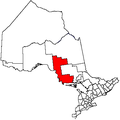External links
- Community profiles (including Hornepayne's) by the Ontario Native Education Counselling Association
- firstnation.ca profile
- Hornepayne First Nation
49°14′02″N84°46′26″W / 49.234°N 84.774°W / 49.234; -84.774
| | This First Nations in Canada–related article is a stub. You can help Wikipedia by expanding it. |
| | This Algoma District geographical article is a stub. You can help Wikipedia by expanding it. |
